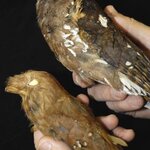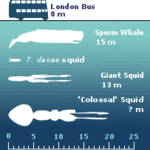Ecology & Zoology
A spectacular fossilised forest has transformed our understanding of the ecology of the Earth’s first rainforests. It is 300 million years old.
The forest is composed of a bizarre mixture of extinct plants: abundant club mosses, more than 40 metres high, towering over a sub-canopy of tree ferns, intermixed with shrubs and tree-sized horsetails. Nowhere elsewhere on the planet is it possible to (literally) walk through such an extensive swathe of Carboniferous rainforest.
Detail of a pteridosperm, an extinct seed-producing fern-like plant. Width across image about six centimeters. Credit:…

Your bird field guide may be out of date now that University of Florida scientists discovered a new genus of frogmouth bird on a South Pacific island.
New genera of living birds are rare discoveries — fewer than one per year is announced globally. David Steadman and Andrew Kratter, ornithologists at the Florida Museum of Natural History, turned up the surprising new discovery on a collecting expedition in the Solomon Islands. Theirs is the first frogmouth from these islands to be caught by scientists in more than 100 years. They immediately recognized it was something different.
A new…

The study reveals the likely mechanism by which the Arabidopsis plant flowers in response to changes in day length. Earlier research had shown that plants' leaves perceived seasonal changes in day length, which triggers a long-distance signal to travel through the plant's vascular system from the leaf to the shoot apex, where flowering is induced. However, the identity of the long-distance signal remained unclear.
This new research, carried out by scientists at Imperial College London and the Max Planck Institute for Plant Breeding Research in Cologne, has led to the proposal that this…

A few days ago we told you about the new hydrothermal vent named Medusa.
They chose that name because that name because they also found a unique pink form of the jellyfish order stauromedusae.
The bell-shaped jellyfish sighted near the vents may be of a new species "because no one has seen this color before," said Karen Von Damm, a geologist at the University of New Hampshire.
According to Von Damm, stauromedusae are usually found away from high-temperature hydrothermal vents, where the fluids are a little bit cooler, not close to the vents as these are.
Aboard the Research Vessel (R/V)…

An international research team has found evidence of the Earth's earliest forest trees, dating back 385 million years.
Upright stumps of fossilised trees were uncovered after a flash flood in Gilboa, upstate New York, more than a century ago. However, until now, no-one has known what the entire trees looked like.
Two years ago, two fossils were found near Gilboa of trees which had fallen sideways, with their trunk, branches, twigs and crown still intact.
American researchers called in Dr Christopher Berry of Cardiff University, an expert who has studied tree fossils around the world for the…
NASA scientists believe they have found a way to predict the color of plants on planets in other solar systems.
Green, yellow or even red-dominant plants may live on extra-solar planets, according to scientists whose two scientific papers appear in the March issue of the journal, Astrobiology. The scientists studied light absorbed and reflected by organisms on Earth, and determined that if astronomers were to look at the light given off by planets circling distant stars, they might predict that some planets have mostly non-green plants.
In the process of photosynthesis, plants convert…

Marine scientists recently published a research paper in the science journal, biology letters, that found humpback whales migrate over 5,100 miles from Central America to their feeding grounds off Antarctica; a record distance undertaken by any mammal.
Kristin Rasmussen, a biologist with Cascadia Research Collective, and lead author in the study, finds the record-breaking migration interesting, but is most pleased that the study validates a long held assumption that humpback whales travel to warm water areas during the winter.
"It was very exciting because for years everyone said humpback…

Escape!
Last night, while Tony and Bobby were beating the bejesus out of each other over a game of Monopoly gone very bad, we faced a situation also fraught with violence, or at least potential violence: the escape of a mouse from Mousefarm.
I say "potential violence" because, if we study man's relationship to mouse so far, it always ends in...bummersville for the mouse. Especially when man is surprised, or startled by mus's rapid, darting shots along the wallboard--the movements that so often evoke the sound known as "eek!" In fact, I will proposed here that the basic…

An amazing Colossal squid was caught last month by fishermen in Antarctica's Ross Sea. It is now on ice, awaiting examination and preparation for its permanent display in New Zealand's national museum. Once un-frozen, the creature will be embalmed and then preserved in a natural position.
The Colossal Squid was first recorded in 1925 after two tentacles were recovered from a sperm whale's stomach. Since then, only a handful of colossal squid have ever been sighted because they live very deep in the ocean. Two others were found in the Ross Sea, and one turned up near South Georgia in 2005.…
Mating strategies are straightforward in bottlenose dolphins, or are they? Much of the work carried on male-female relationships in that species to date show that males tend to coerce females who are left with little choice about with whom to mate. This explains the complex relationships we observe in male bottlenose dolphins, which are only paralleled by human social strategies: the formation of alliances and alliances of alliances, also called coalitions. These alliances and coalitions are then used to out-compete other male bands to access females.
Credit: David Lusseau, 2001
A…